How To Sum Cells When Value Changes In Another Column
The tutorial explains how to do sum in Excel past using the AutoSum feature, and how to make your own SUM formula to full a column, row or selected range. Y'all will besides acquire how to sum only visible cells, calculate running total, sum beyond sheets, and find out why your Excel Sum formula is not working.
If you desire a quick sum of certain cells in Excel, yous tin can merely select those cells, and look at the condition bar at the bottom right corner of your Excel window:

For something more permanent, utilise the Excel SUM part. It is very simple and straightforward, so even if you are a beginner in Excel, you will hardly take any difficulty in understanding the following examples.
How to sum in Excel using a elementary arithmetic adding
If you demand a quick full of several cells, you can utilise Microsoft Excel as a mini figurer. Just utilize the plus sign operator (+) like in a normal arithmetics operation of addition. For case:
=ane+2+3
or
=A1+C1+D1

Nonetheless, if you lot demand to sum a few dozen or a few hundred rows, referencing each cell in a formula does not audio similar a good thought. In this case, you can utilize the Excel SUM function specially designed to add together a specified set of numbers.
How to use SUM function in Excel
Excel SUM is a math and trig part that adds values. The syntax of the SUM function is as follows:
SUM(number1, [number2] ,…)
The first argument is required, other numbers are optional, and you tin can supply upward to 255 numbers in a single formula.
In your Excel SUM formula, each argument tin can be a positive or negative numeric value, range, or cell reference. For example:
=SUM(A1:A100)
=SUM(A1, A2, A5)
=SUM(1,5,-ii)
The Excel SUM function is useful when you need to add together upwards values from different ranges, or combine numeric values, jail cell references and ranges. For instance:
=SUM(A2:A4, A8:A9)
=SUM(A2:A6, A9, 10)
The below screenshot shows these and a few more than SUM formula examples:
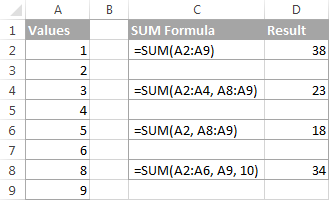
In existent-life worksheets, the Excel SUM function is often included in bigger formulas as function of more complex calculations.
For example, you can embed SUM in the value_if_true argument of the IF office to add numbers in columns B, C and D if all 3 cells in the same row comprise values, and show a alarm message if any of the cells is blank:
=IF(AND($B2<"", $C2<>"", $D2<>""), SUM($B2:$D2), "Value missing")
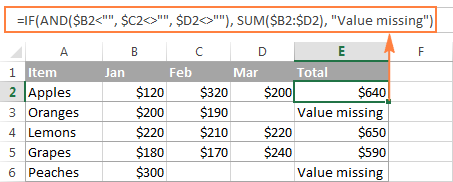
And hither's another case of using an advanced SUM formula in Excel: VLOOKUP and SUM formula to total all matching values.
How to AutoSum in Excel
If you need to sum one range of numbers, whether a column, row or several side by side columns or rows, y'all can allow Microsoft Excel write an appropriate SUM formula for you.
Simply select a prison cell next to the numbers yous want to add, click AutoSum on the Dwelling house tab, in the Editing group, press the Enter key, and you will accept a Sum formula inserted automatically:
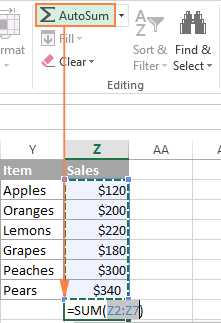
As you lot can see in the following screenshot, Excel'south AutoSum feature not only enters a Sum formula, but also selects the nearly likely range of cells that yous'd want to total. 9 times out of ten, Excel gets the range right. If not, you can manually correct the range by simply dragging the cursor through the cells to sum, and and so striking the Enter primal.
Tip. A faster way to do AutoSum in Excel is to use the Sum shortcut Alt + =. Merely hold the Alt key, press the Equal Sign key, and and so hit Enter to complete an automatically inserted Sum formula.
Apart from computing total, you lot can use AutoSum to automatically enter Average, COUNT, MAX, or MIN functions. For more than information, please check out the Excel AutoSum tutorial.
How to sum a column in Excel
To sum numbers in a specific column, you can use either the Excel SUM role or AutoSum characteristic.
For example, to sum values in cavalcade B, say in cells B2 to B8, enter the following Excel SUM formula:
=SUM(B2:B8)
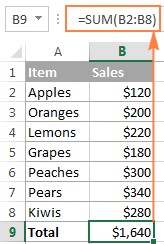
Total an entire column with indefinite number of rows
If a cavalcade you want to sum has a variable number of rows (i.eastward. new cells tin exist added and existing ones can be deleted at any time), you tin sum the unabridged column by supplying a column reference, without specifying a lower or upper bound. For example:
=SUM(B:B)
Important note! In no instance y'all should put your 'Sum of a column' formula in the cavalcade you desire to full considering this would create a circular cell reference (i.e. an endless recursive summation), and your Sum formula would return 0.
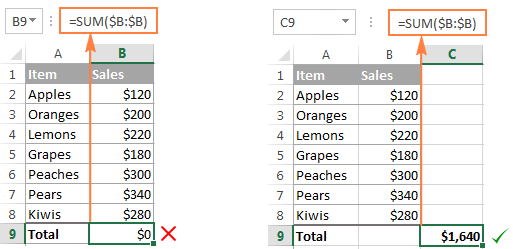
Sum column except header or excluding a few first rows
Usually, supplying a column reference to the Excel Sum formula totals the unabridged column ignoring the header, as demonstrated in the in a higher place screenshot. Merely in some cases, the header of the cavalcade you want to total can really take a number in it. Or, yous may want to exclude the first few rows with numbers that are not relevant to the data you want to sum.
Regrettably, Microsoft Excel does not accept a mixed SUM formula with an explicit lower bound but without an upper bound similar =SUM(B2:B), which works fine in Google Sheets. To exclude the first few rows from summation, you can use one of the following workarounds.
- Sum the entire cavalcade then subtract the cells yous don't desire to include in the full (cells B1 to B3 in this example):
=SUM(B:B)-SUM(B1:B3)
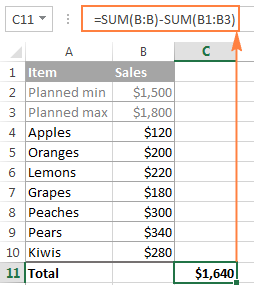
- Remembering the worksheet size limits, you tin can specify the upper bound of your Excel SUM formula based on the maximum number of rows in your Excel version.
For example, to sum column B without the header (i.e. excluding cell B1), you lot can use the following formulas:
- In Excel 2007, Excel 2010, Excel 2013, and Excel 2016:
=SUM(B2:B1048576) - In Excel 2003 and lower:
=SUM(B2:B655366)
How to sum rows in Excel
Similarly to totaling a column, you lot can sum a row in Excel by using the SUM function, or have AutoSum to insert the formula for yous.
For example, to add values in cells B2 to D2, use the post-obit formula:
=SUM(B2:D2)

How to sum multiple rows in Excel
To add values in each row individually, just elevate down your Sum formula. The key point is to use relative (without $) or mixed cell references (where the $ sign fixes but the columns). For example:
=SUM($B2:$D2)
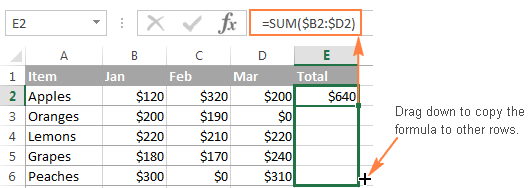
To total the values in a range containing several rows, simply specify the desired range in the Sum formula. For case:
=SUM(B2:D6) - sums values in rows ii to 6.
=SUM(B2:D3, B5:D6) - sums values in rows 2, 3, five and 6.
How to sum a whole row
To sum the entire row with an indefinite number of columns, supply a whole-row reference to your Excel Sum formula, eastward.g.:
=SUM(2:2)
Please remember that you lot shouldn't enter that 'Sum of a row' formula in any cell of the same row to avoid creating a circular reference considering this would result in a incorrect calculation, if any:

To sum rows excluding a sure cavalcade(southward), total the entire row and then decrease irrelevant columns. For example, to sum row two except the first 2 columns, use the following formula:
=SUM(2:two)-SUM(A2:B2)
Use Excel Full Row to sum data in a table
If your data is organized in an Excel table, yous can benefit from the special Total Row feature that tin can quickly sum the data in your tabular array and brandish totals in the terminal row.
A big reward of using Excel tables is that they auto-aggrandize to include new rows, so whatever new data you input in a table will be included in your formulas automatically. If tin learn about other benefits of Excel tables in this article: 10 most useful features of Excel tables.
To convert an ordinary range of cells into a table, select it and press Ctrl + T shortcut (or click Table on the Insert tab).
How to add together a total row in Excel tables
In one case your information is bundled in a table, yous can insert a full row in this way:
- Click anywhere in the tabular array to display the Tabular array Tools with the Design tab.
- On the Design tab, in the Table Mode Options grouping, select the Full Row box:

Another way to add a full row in Excel is to correct click any cell within the table, and and so click Table > Totals Row.

How to full data in your tabular array
When the total row appears at the end of the table, Excel does its best to determine how y'all would similar to calculate data in the table.
In my sample table, the values in column D (rightmost column) are added automatically and the sum is displayed in the Total Row:
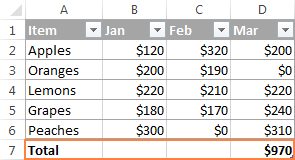
To total values in other columns, merely select a corresponding prison cell in the total row, click the drop-downward list arrow, and select Sum:
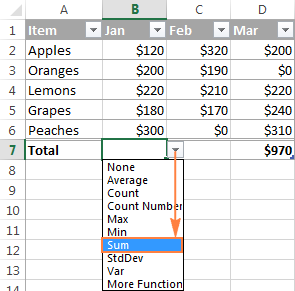
If you want to perform some other calculation, select the corresponding function from the drop-down list such as Average, Count, Max, Min, etc.
If the total row automatically displays a total for a column that doesn't need one, open the dropdown list for that cavalcade and select None.
Notation. When using the Excel Total Row feature to sum a cavalcade, Excel totals values just in visible rows past inserting the SUBTOTAL function with the first argument set to 109. Yous will find the detailed explanation of this function in the next department.
If you want to sum data both in visible and invisible rows, do not add the total row, and use a normal SUM function instead:

How to sum only filtered (visible) cells in Excel
Sometimes, for more effective date analysis, you may demand to filter or hibernate some information in your worksheet. A usual Sum formula won't work in this case considering the Excel SUM function adds all values in the specified range including the hidden (filtered out) rows.
If you desire to sum only visible cells in a filtered list, the fastest way is to organize your data in an Excel table, and so plow on the Excel Total Row characteristic. As demonstrated in the previous example, selecting Sum in a tabular array'due south full row inserts the SUBTOTAL function that ignores hidden cells.
Some other mode to sum filtered cells in Excel is to employ an AutoFilter to your data manually past clicking the Filter push on the Data tab. And then, write a Subtotal formula yourself.
The SUBTOTAL role has the following syntax:
SUBTOTAL(function_num, ref1, [ref2],…)
Where:
- Function_num- a number from one to 11 or from 101 to 111 that specifies which part to use for the subtotal.
Y'all can find the full list of functions on support.office.com. For now, we are interested only in the SUM function, which is defined by numbers ix and 109. Both numbers exclude filtered-out rows. The difference is that nine includes cells hidden manually (i.e. right-click > Hide), while 109 excludes them.
Then, if yous are looking to sum only visible cells, regardless of how exactly irrelevant rows were hidden, then use 109 in the first statement of your Subtotal formula.
- Ref1, Ref2, … - cells or ranges that you want to subtotal. The commencement Ref statement is required, others (up to 254) are optional.
In this example, let's sum visible cells in range B2:B14 by using the post-obit formula:
=SUBTOTAL(109, B2:B14)

And at present, let's filter merely 'Banana' rows and make sure that our Subtotal formula sums only visible cells:
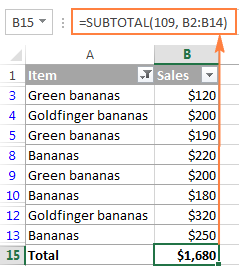
Tip. Yous can have Excel's AutoSum characteristic to insert the Subtotal formula for you lot automatically. Just organize your data in tabular array (Ctrl + T) or filter the data the way yous want by clicking the Filter button. Later on that, select the cell immediately below the cavalcade you desire to total, and click the AutoSum button on the ribbon. A SUBTOTAL formula will be inserted, summing simply the visible cells in the column.
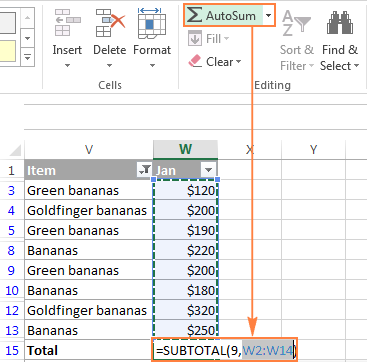
How to do a running total (cumulative sum) in Excel
To calculate a running full in Excel, you write a usual SUM formula with a clever utilize of absolute and relative cells references.
For case, to display the cumulative sum of numbers in column B, enter the following formula in C2, and so re-create it down to other cells:
=SUM($B$2:B2)
The relative reference B2 will alter automatically based on the relative position of the row in which the formula is copied:
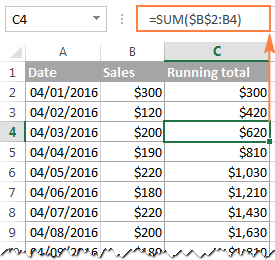
You can find the detailed caption of this bones Cumulative Sum formula and tips on how to improve it in this tutorial: How to calculate running full in Excel.
How to sum across sheets
If you have several worksheets with the same layout and the aforementioned data type, you tin can add the values in the same cell or in the same range of cells in different sheets with a single SUM formula.
A then-chosen iii-D reference is what does the fox:
=SUM(Jan:Apr!B6)
Or
=SUM(Jan:Apr!B2:B5)
The first formula adds values in cell B6, while the 2d formula sums the range B2:B5 in all worksheets located between the two boundary sheets that you specify (January and April in this example):

Yous can discover more than data near a three-d reference and the detailed steps to create such formulas in this tutorial: How to create a 3-D reference to calculate multiple sheets.
Excel conditional sum
If your task requires adding only those cells that run across a certain condition or a few conditions, you can employ the SUMIF or SUMIFS function, respectively.
For example, the following SUMIF formula adds only those amounts in column B that have "Completed" status in cavalcade C:
=SUMIF(C:C,"completed",B:B )

To calculate a provisional sum with multiple criteria, utilise the SUMIFS function. In the above case, to get the full of "Completed" orders with the amount over $200, employ the following SUMIFS formula:
=SUMIFS(B:B,C:C,"completed",B:B, ">200" )
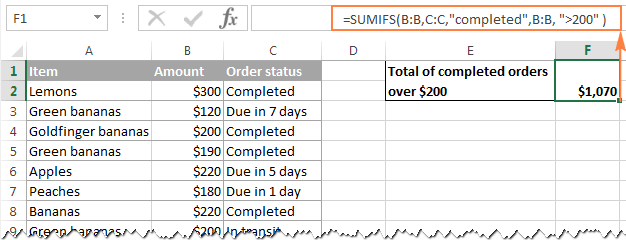
You lot can observe the detailed explanation of the SUMIF and SUMIFS syntax and plenty more than formula examples in these tutorials:
- SUMIF function in Excel: examples for numbers, dates, text, blanks and non blanks
- SUMIF in Excel - formula examples to conditionally sum cells
- How to use Excel SUMIFS and SUMIF with multiple criteria
Note. The Provisional Sum functions are available in Excel versions beginning with Excel 2003 (more precisely, SUMIF was introduced in Excel 2003, while SUMIFS only in Excel 2007). If someone still uses an before Excel version, you'd demand to brand an array SUM formula every bit demonstrated in Using Excel SUM in array formulas to conditionally sum cells.
Excel SUM not working - reasons and solutions
Are you trying to add a few values or full a column in your Excel sheet, just a simple SUM formula doesn't compute? Well, if the Excel SUM function is not working, it'southward most probable because of the following reasons.
1. #Proper noun mistake appears instead of the expected result
It's the easiest error to fix. In 99 out of 100 cases, the #Proper noun error indicates that the SUM function is misspelled.
2. Some numbers are non added
Another common reason for a Sum formula (or Excel AutoSum) non working are numbers formatted as text values. At get-go sight, they expect like normal numbers, but Microsoft Excel perceives them as text strings and leaves them out of calculations.
Ane of the visual indicators of text-numbers are the default left alignment and light-green triangles in pinnacle-left corner of the cells, similar in the correct-hand canvass in the below screenshot:

To gear up this, select all problematic cells, click the alert sign, and then click Convert to Number.
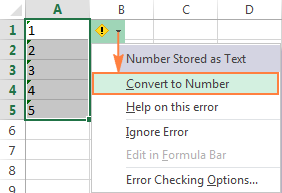
If confronting all expectations that does not work, effort other solutions described in: How to fix numbers formatted as text.
3. Excel SUM function returns 0
Autonomously from numbers formatted as text, a circular reference is a common source of problem in Sum formulas, particularly when you are trying to total a column in Excel. And so, if your numbers are formatted as numbers, but your Excel Sum formula yet returns zero, trace and gear up the circular references in your sail (Formula tab > Mistake Checking > Circular Reference). For the detailed instructions, please see How to find a circular reference in Excel.
4. Excel Sum formula returns a higher number than expected
If against all expectations your Sum formula returns a bigger number than it should, remember that the SUM role in Excel adds both visible and invisible (hidden) cells. In this case, utilise the Subtotal function instead, as demonstrated in How to sum only visible cells in Excel.
v. Excel SUM formula not updating
When a SUM formula in Excel continues to show the former total fifty-fifty afterward you've updated the values in the dependent cells, almost likely Calculation Mode is set to Manual. To fix this, go to the Formulas tab, click the dropdown arrow adjacent to Calculate Options, and click Automatic.
Well, these are the well-nigh common reasons for SUM not working in Excel. If none of the above is your case, check out other possible reasons and solutions: Excel formulas non working, not updating, not calculating.
This is how you use a SUM office in Excel. If y'all want to have a closer look at the formula examples discussed in this tutorial, you are welcome to download a sample Excel SUM workbook. I thank you for reading and promise to meet you on our weblog side by side week.
You may also be interested in
How To Sum Cells When Value Changes In Another Column,
Source: https://www.ablebits.com/office-addins-blog/2016/05/18/excel-sum-formula-total-column-rows-cells/
Posted by: smithmoused1964.blogspot.com


0 Response to "How To Sum Cells When Value Changes In Another Column"
Post a Comment